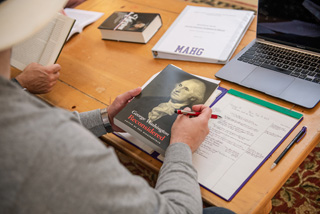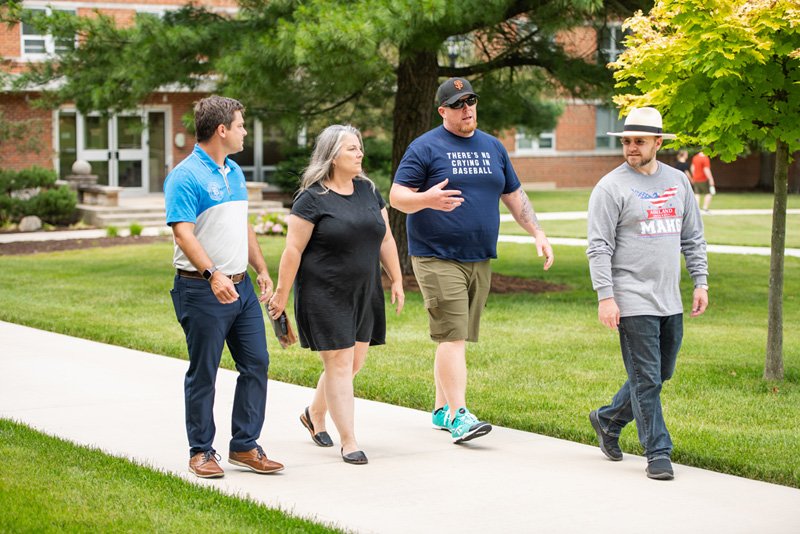Summer has arrived! And that means the pinnacle of TAH’s professional development for teachers has arrived as well: our Master of Arts in American History and Government (MAHG) program at Ashland University in Ashland, OH.
Every summer, hundreds of teachers from around the country join us for week-long classes on topics ranging from early American history to modern political institutions. The one day seminars we hold around the country provide in-depth learning from document-based discussions, but the experience is amplified during the summer residence program.
There’s the obvious benefit of more time than in our one day seminars, with several days to develop your expertise in the topics you’re interested in. But that’s just the start. Teachers and professors live together on campus, sharing meals and continuing the discussions outside of class. Add to this the serenity and seclusion of our campus, and it’s no wonder so many incredible teachers keep coming back every summer.
But all good things eventually end, and some of our students will be finishing their final classes this summer. Teachers at the end of the program can choose to complete either a traditional master’s thesis, a capstone project, or our qualifying exam. With the qualifying exam being the option most of our students choose, we’d like to take a look at the structure of this exam and how to perform well on it.
The exam will be released to students on a Friday, and they will have a little over two weeks to submit their final answers. The exam has two parts. The first part asks students to analyze a short text. The second part consists of four questions. Students answer two of these. The four questions cover a variety of topics, eras, or themes in American history and government. Each question has a corresponding document to analyze in your response.
Tips for Succeeding on the Exam
The first part of the exam comes with detailed instructions that describe what the analysis should consist of. The key is to focus on the argument in the document; don’t get lost in the weeds of irrelevant historical context for this part of the exam.
It’s common for teachers to overlook the arguments in the document. Frequently, teachers will try to do too much and forget to provide this basic analysis. They dive right into the historical context or how the document fits into a larger debate and neglect to take a close look at the document itself.
While the historical context is relevant to the question being asked, it’s important to demonstrate a thorough understanding of the document itself. For what purpose was it written? Who was its intended audience? What effect did it have? One of the benefits to learning through primary sources is developing an ability to understand others as they would understand themselves, so set aside time to make sure you reveal this ability in your responses.

Another common danger teachers run into is running out of time to complete the essays. We encourage you to take full advantage of all three weekends between the release of the exam and its submission deadline. Start right away to give yourself time to proofread, revise, and edit later.
Save your notes from class! If you’re not a pack rat and can’t save them all, you should at least consider saving notes from the core or required courses in our program (501, 502, 503, 505, 506, and 507). These courses lay an excellent foundation for a deep understanding of the history and government of America. From the American Revolution through the Rise of Modern America, you’ll have plenty of material to draw from to help you answer the questions in your essay.
Take breaks in your writing to revisit later. It may feel like you won’t have time, but you’ll benefit from looking back over your work with a fresh set of eyes. This is also why it’s important to start writing that first weekend you get the questions. You need to have words on the page to work with later after you’ve had time to reflect more on the document and what you’d like to include about it.
Get feedback from the friends you’ve made in the program. We always encourage our students to form study groups for their classes on campus, so continue to make use of the connections you’ve made when working on this exam. Someone familiar with our classes will help you see if you’ve strayed into irrelevance in your answer.
It can also be helpful to try asking people with no knowledge of the topic to proofread your essay for you. English teachers you work with can offer valuable feedback on the coherence of your answers without getting lost in the technicalities of the content. Additional sets of eyes reading back through what you wrote will help you know whether you’ve fully addressed the prompt and thoroughly analyzed the document.
Conclusion
The Qualifying Exam may be intimidating, but as with all of the challenges in the MAHG program it’s also a rewarding way to finish your studies. It will remind you how much you learned over the years in our program, and you’ll leave with that familiar sense of pride when you push your brain to its limits thinking through topics worthy of serious study.

